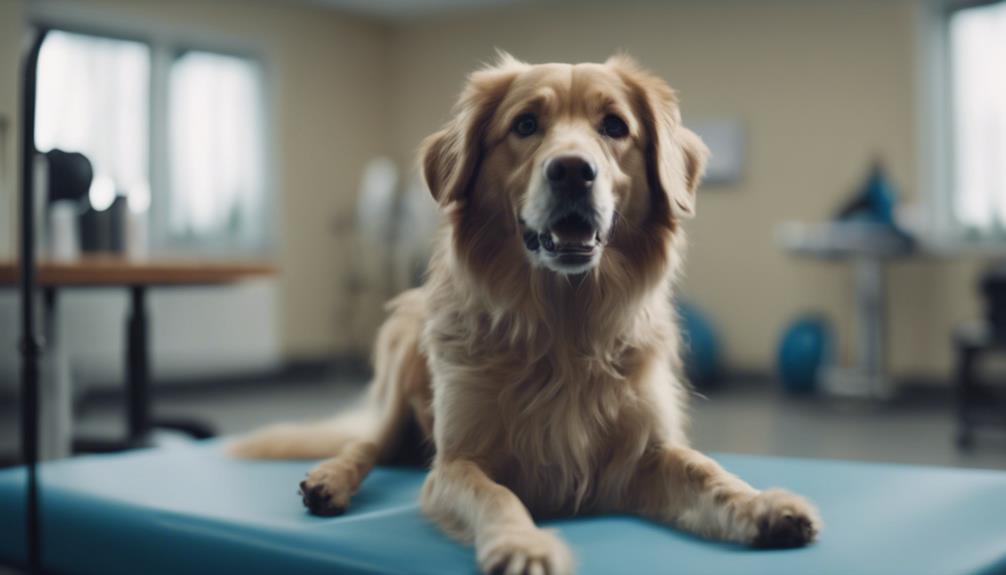Canine Vestibular Disease, commonly known as vertigo in dogs, is a condition that perplexes both pet owners and veterinarians alike due to its intricate nature.
The manifestation of symptoms such as head tilting and loss of balance can be alarming, prompting a deeper exploration into the intricacies of this disorder.
With various potential triggers and a predisposition in certain breeds, understanding the complexities of Canine Vestibular Disease becomes pivotal in ensuring the well-being of our canine companions.
Key Takeaways
- Canine vestibular disease disrupts balance and orientation due to vestibular brain dysfunction.
- Symptoms include head tilt, nystagmus, nausea, and difficulty standing or walking.
- No specific breed or age is immune, but older dogs are more susceptible.
- Treatment varies based on the underlying cause, with supportive care and possible surgery or medication.
Understanding Canine Vestibular Disease
Canine Vestibular Disease is a condition characterized by disturbances in balance and orientation due to disruptions in the vestibular part of the brain. Symptoms such as head tilt, a drunken appearance, and nystagmus can be alarming for pet owners. While most cases are idiopathic, triggers such as ear infections, brain tumors, stroke, or trauma can also lead to this condition.
Dogs may exhibit signs of nausea, vomiting, difficulty standing, and walking in circles. Recovery typically occurs within weeks to months, with supportive care playing a crucial role. Understanding the nuances of Canine Vestibular Disease is essential for timely intervention and management to ensure the well-being and comfort of our canine companions.
Causes and Triggers of Vestibular Disease
Factors contributing to the onset of vestibular disease in dogs include:
- Disruption in the vestibular part of the brain affecting balance and orientation.
- Idiopathic cases with unknown causes are common.
- Triggers such as ear infections, brain tumors, stroke, or trauma can lead to vestibular disease.
- Certain breeds like French bulldogs and Jack Russell terriers may have a higher incidence of vestibular issues.
Understanding these potential causes and triggers is crucial in identifying and managing vestibular disease in dogs effectively.
Recognizing Symptoms in Dogs

Recognizing the symptoms of vestibular disease in dogs is crucial for timely identification and appropriate management. Common signs include a noticeable head tilt, a drunken appearance, and nystagmus (involuntary eye movements).
Nausea, vomiting, walking in circles, and falling to one side are also indicative of the condition. Dogs may exhibit an inability to stand or walk without support, and their symptoms can mimic stroke-like behavior.
It is essential to observe these signs carefully and seek veterinary assistance promptly. While recovery typically occurs within weeks to months, early detection can aid in providing supportive care and determining the underlying cause more effectively.
Vigilance in recognizing these symptoms can lead to better outcomes for dogs affected by vestibular disease.
Susceptible Dog Breeds and Ages
Certain dog breeds and age groups exhibit a higher susceptibility to developing vestibular disease. Notable predispositions are seen in breeds such as French bulldogs, Jack Russell terriers, and Cocker spaniels, particularly observed in older canine populations.
French bulldogs, Jack Russell terriers, and Cocker spaniels are more prone to developing vestibular disease. Older dogs are at a higher risk of experiencing vestibular issues. Genetic factors may play a role in predisposing certain breeds to this condition.
Regular veterinary check-ups are essential for early detection and management of vestibular disease in susceptible breeds and older dogs.
Tailored Treatment Approaches

In addressing canine vestibular disease, tailored treatment approaches are essential to effectively manage the condition, especially in susceptible dog breeds and older canine populations. Treatment strategies vary depending on the underlying cause of the vestibular disease. For instance, ear infections can often be managed with medication or surgical intervention, while brain tumors may require more aggressive approaches such as surgery, radiation therapy, or chemotherapy.
Diagnostic tools like CT or MRI scans play a crucial role in determining the appropriate course of action. Additionally, supportive care including anti-nausea medication and creating a comfortable environment can help alleviate symptoms and aid in the overall recovery process. By customizing treatment plans to suit each individual case, veterinarians can optimize outcomes for dogs affected by vestibular disease.
Diagnostic Tools for Vestibular Disease
Diagnostic tools play a pivotal role in identifying and evaluating the underlying causes of vestibular disease in dogs. These tools aid veterinarians in pinpointing the specific issue, guiding treatment decisions, and predicting outcomes. Key diagnostic methods include:
- Neurological Examination: Assesses reflexes, coordination, and cranial nerve function.
- Blood Tests: Help rule out infections, organ dysfunction, or metabolic issues.
- Imaging Studies (CT or MRI): Provide detailed images of the brain, inner ear, and surrounding structures.
- Cerebrospinal Fluid Analysis: Helps detect inflammation, infection, or cancerous cells in the central nervous system.
Utilizing these diagnostic tools enables a comprehensive assessment of the canine patient, leading to more targeted and effective treatment strategies.
Supportive Care and Recovery

Supportive care plays a crucial role in aiding dogs with vestibular disease towards recovery, facilitating comfort and stability during their healing process. This care involves creating a safe and comfortable environment for the affected dog, as they may have difficulty balancing and coordinating movements. Providing soft bedding and minimizing environmental stressors can help in their recovery.
Additionally, anti-nausea medication can be administered to alleviate symptoms like vomiting and nausea. Feeding a bland diet and offering small, frequent meals can prevent gastrointestinal upset. Physical therapy exercises may also be beneficial in improving coordination and strength.
With proper supportive care, most dogs with vestibular disease show improvement within weeks to months, gradually regaining their balance and quality of life.
Conclusion
In conclusion, Canine Vestibular Disease, also known as vertigo in dogs, presents a complex array of symptoms that can be alarming for pet owners.
Understanding the causes, triggers, symptoms, susceptible breeds, and treatment options for this condition is crucial for providing effective care and support for affected dogs.
With proper diagnosis and tailored treatment approaches, dogs suffering from vestibular disease can receive the necessary care to improve their quality of life and promote recovery.




